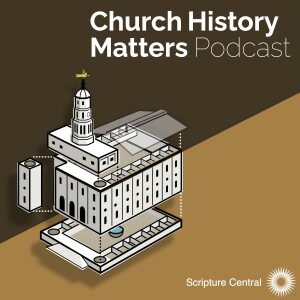Episodes

Monday Mar 24, 2025
Monday Mar 24, 2025
Welcome to Church History Matters Come Follow Me Edition where we are systematically diving into every section of the Doctrine and Covenants throughout the year 2025! In this episode Scott and Casey cover Doctrine and Covenants 27-28 while offering their insights into the context, content, controversies, and consequences of these important sections.

Tuesday Mar 18, 2025
Tuesday Mar 18, 2025
Welcome to Church History Matters Come Follow Me Edition where we are systematically diving into every section of the Doctrine and Covenants throughout the year 2025! In this episode Scott and Casey interview Jennifer Reeder about Emma Smith in this bonus "Voices of the Restoration" episode.

Tuesday Mar 11, 2025
Tuesday Mar 11, 2025
Welcome to Church History Matters Come Follow Me Edition where we are systematically diving into every section of the Doctrine and Covenants throughout the year 2025! In this episode Scott and Casey cover Doctrine and Covenants 23-26 while offering their insights into the context, content, controversies, and consequences of these important sections.

Tuesday Mar 04, 2025
Tuesday Mar 04, 2025
Welcome to Church History Matters Come Follow Me Edition where we are systematically diving into every section of the Doctrine and Covenants throughout the year 2025! In this episode Scott and guest host Anthony Sweat cover Doctrine and Covenants 20-22 while offering their insights into the context, content, controversies, and consequences of these important sections.

Wednesday Feb 26, 2025
Wednesday Feb 26, 2025
Welcome to Church History Matters Come Follow Me Edition where we are systematically diving into every section of the Doctrine and Covenants throughout the year 2025! In this episode Scott and Casey cover Doctrine and Covenants 19 while offering their insights into the context, content, controversies, and consequences of these important sections.

Tuesday Feb 18, 2025
Tuesday Feb 18, 2025
Welcome to Church History Matters Come Follow Me Edition where we are systematically diving into every section of the Doctrine and Covenants throughout the year 2025! In this episode Scott and Casey cover Doctrine and Covenants 18 while offering their insights into the context, content, controversies, and consequences of these important sections.

Thursday Feb 13, 2025
Thursday Feb 13, 2025
Welcome to Church History Matters Come Follow Me Edition where we are systematically diving into every section of the Doctrine and Covenants throughout the year 2025! In this episode Scott and Casey interview Daniel C. Petersen about the Book of Mormon Witnesses in this bonus "Voices of the Restoration" episode.

Tuesday Feb 11, 2025
Tuesday Feb 11, 2025
Welcome to Church History Matters Come Follow Me Edition where we are systematically diving into every section of the Doctrine and Covenants throughout the year 2025! In this episode Scott and Casey cover Doctrine and Covenants 12-17 while offering their insights into the context, content, controversies, and consequences of these important sections.

Tuesday Feb 04, 2025
Tuesday Feb 04, 2025
Welcome to Church History Matters Come Follow Me Edition where we are systematically diving into every section of the Doctrine and Covenants throughout the year 2025! In this episode Scott and Casey cover Doctrine and Covenants 10-11 while offering their insights into the context, content, controversies, and consequences of these important sections.

Saturday Feb 01, 2025
Saturday Feb 01, 2025
Welcome to Church History Matters Come Follow Me Edition where we are systematically diving into every section of the Doctrine and Covenants throughout the year 2025! In this episode Scott and Casey interview John W. Welch about the miraculous translation of the Book of Mormon in this bonus "Voices of the Restoration" episode.









